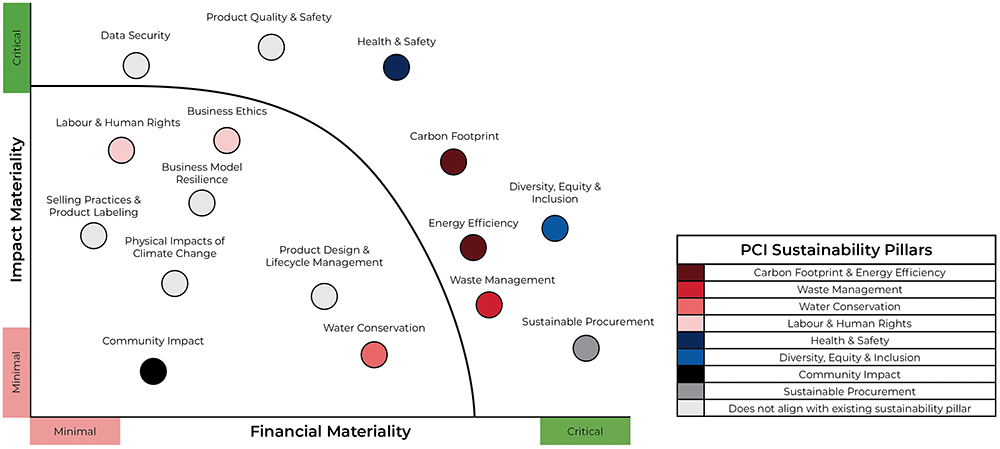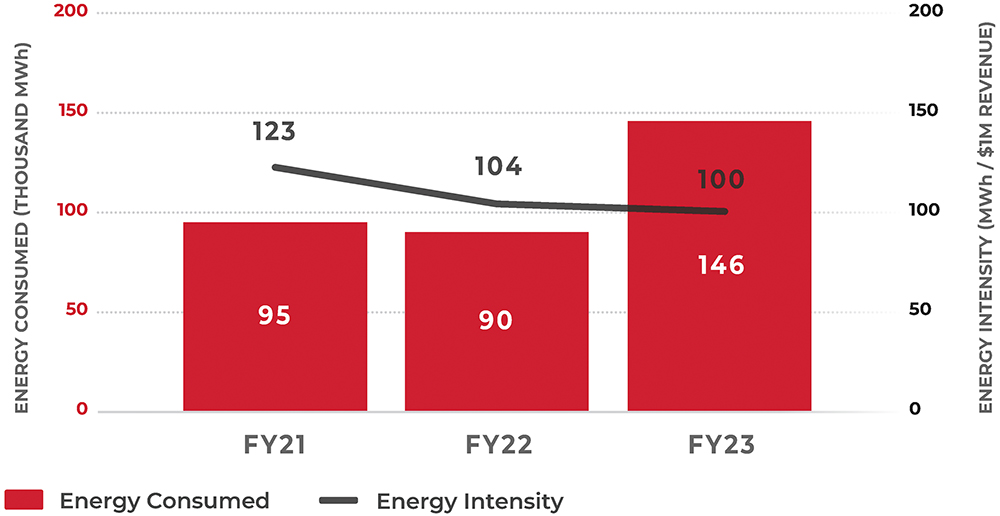To Issue 159
Citation: Bat-Edene G, “PCI’s ESG Journey – Establishing Processes and Driving Results”. ONdrugDelivery, Issue 159 (Apr/May 2024), pp 72–74.
Gigi Bat-Edene discusses the steps that PCI has taken towards realising its environmental, social and governance targets and achieving reductions in its greenhouse gas emissions in the journey towards net zero.
Historically, the pharma industry has not been a leader in Environmental Social Governance (ESG). Despite pharma’s significant progress in decreasing global greenhouse gas emissions compared with other industries, it is still lagging behind immensely. However, due to the recent focus on sustainability, environmental regulations and social justice, it is expected that more pharma companies will step up and integrate ESG into their short- and long-term strategies. The truth is that ESG-related challenges will not be overcome overnight; it is a continuous journey with no end point. To achieve meaningful progress and tangible results, ESG must be woven into the very fabric of a business.
“Positive change is certainly achievable. Pharma companies need to become stewards of positive change in the industry by monitoring their direct and indirect impacts on the environment and their surrounding communities.”
For companies in the early stages of developing their own sustainability programs, this can seem like a daunting task but, by taking small steps and establishing the right frameworks, making positive change is certainly achievable. Pharma companies need to become stewards of positive change in the industry by monitoring their direct and indirect impacts on the environment and their surrounding communities, mitigating hazardous risks and identifying opportunities for continuous improvement. Setting goals and aligning high-impact action plans will help drive success in these areas.
From both an environmental and social standpoint, companies must first identify their main impacts related to its activities. PCI has shared its ESG journey in detail in its inaugural ESG Report FY23, which was published in March 2024. This article focuses on PCI’s process for conducting materiality assessment and using the insights gained to develop science-based targets.
CONDUCTING A DOUBLE MATERIALITY ASSESSMENT
A double materiality assessment is a two-phased approach used to gauge what internal and external stakeholders identify as material issues relevant to the company. Going beyond a focus on the financial, it considers ESG factors that can impact both the organisation and its stakeholders. This is a highly recommended first step on a company’s ESG journey.
In 2022, PCI conducted the first phase of its materiality assessment. The company engaged employees, leaders and investors, interviewing them – both in one-on-one and group settings – and collecting their input on the topics that are most important to them and where they felt PCI should be prioritising its efforts. Based on the expected impact on stakeholders, strategic business value and the Sustainability Account Standards Board standards, PCI identified its nine impact categories and 20 initial quantitative indicators.
The following year, PCI carried out the second phase. The company surveyed more than 600 external stakeholders, including customers, suppliers, investors and local community partners, asking them to rank sustainability issues in order of importance. Given PCI’s emphasis on local impact, it was critical to include the voices of community members and partner organisations in the company’s ESG programme.
This two-phased approach enabled the company to gain a comprehensive understanding of stakeholder priorities and concerns, informing PCI’s long-term business strategy. These insights are being used as a fundamental building block to determine which metrics to track, what to disclose and where to focus meaningful performance improvements in the future (Figure 1).

Figure 1: PCI’s double materiality assessment results.
ACCELERATING IMPACT WITH SCIENCE-BASED TARGETS
PCI has aligned its environmental targets and action plans with the latest recommendations set forth by the Science Based Targets Initiative (SBTi). Science-based target setting enables an ambitious, credible and clearly defined emissions reduction pathway for companies that are serious about preventing the worst impacts of climate change. In line with the latest climate science, PCI has committed to reducing its total greenhouse gas (GHG) emissions, using resources efficiently, investing in renewable energy and adopting new ways of conducting business (Figure 2).

Figure 2: PCI’s 2022–2023 financial year reporting period included several new sites, accounting for the increase in total energy consumption from the 2022–2023 to the 2023–2024 financial years. During the same time period, PCI’s energy consumption intensity has declined, reflecting an overall reduction in its energy consumption intensity despite the addition of new business sites.
PCI’s GHG emissions are a by product of:
- Scope 1 (direct emissions): On-site manufacturing activities, heating, cooling, refrigerants
- Scope 2 (indirect emissions): Purchased electricity
- Scope 3 (supply chain emissions): Upstream and downstream activities, such as business travel, employee commuting, transportation and distribution of products.
Globally, PCI has established the following emission reduction targets for Scopes 1 and 2:
- 40% reduction in Scope 1 and 2 GHG emissions intensity (normalised to revenue) by 2030. As part of this commitment, PCI has signed a letter with the SBTi and will submit targets for verification before 2025
- 50% reduction in energy intensity by 2030 (normalised to revenue)
- 100% renewable energy purchased by 2030.
Globally, PCI is working towards the following emission reduction target for Scope 3:
- A net-zero Scope 3 value chain by 2045.
Assessing company-related carbon footprint and energy usage, and establishing formal targets based on them, is a crucial first step. However, tangible efforts to actually limit global warming to below 1.5°C above pre-industrial levels by 2030 require companies to go beyond their four walls and focus on the wider value chain. After all, Scope 3 emissions often account for the vast majority of a company’s carbon footprint. This is why PCI regards its supply chain to be an essential area to focus on and its suppliers as key partners in the race to a net-zero future.
“Internally, companies should assemble a multidisciplinary team specifically dedicated to ESG and conduct a materiality assessment to identify stakeholder priorities and align their short- and long-term goals accordingly.”
MAKING A COMMITMENT TO ACTIONABLE CHANGE
To define actions that will achieve the company’s Scope 1 & 2 reduction targets, PCI collected ideas from employees, researched industry best practices and identified the following high-impact action plans:
- Creating and updating policies to require that new purchases and processes consider environmental impacts in line with targets
- Changing all facility lighting to use light-emitting diodes (LEDs)
- Implementing leak detectors for energy-intensive systems, including compressed air
- Implementing a refrigerant-use tracking and reporting system, along with a “traffic light” system to switch off equipment not in use.
As PCI continues to increase the granularity of its Scope 3 baseline and prepares to submit its targets for SBTi validation, the company is taking the following strides:
- Identifying relevant Scope 3 categories using publicly available data, along with internal spend-based data, to capture Scope 3 measurements, and is in the process of selecting credible partners for data accuracy and progress towards a net-zero strategy
- Updating company policies and procedures to reflect ESG commitments and outline expectations to reach the company’s targets
- Assessing ESG and carbon footprint maturity of the company’s top spend suppliers via ESG assessments and identifying opportunities for emission reductions, training and collaboration
- Prioritising suppliers that align with the company’s ESG vision, commit to science-based targets and comply with PCI’s responsible suppliers standards.
PCI has signed up to be part of the “Race to Zero” and the “Business Ambition for 1.5°C” campaigns – the world’s largest and fastest growing group of companies that are aligning with 1.5°C by helping to halve global emissions by 2030. In joining this call to action, PCI has been showcased by the SBTi, the UN Global Compact and the We Mean Business Coalition.
CONCLUSION
Every company around the globe is expected to reduce its carbon footprint across its operations and entire supply chain. Pharmaceutical companies have the added challenges of a restrictive regulatory environment and a lack of cohesive ESG standards. However, it is possible to overcome these challenges.
Internally, companies should assemble a multidisciplinary team specifically dedicated to ESG and conduct a materiality assessment to identify stakeholder priorities and align their short- and long-term goals accordingly. From there, this team can partner with the leadership to develop an ESG strategy, after which the entire organisation will need to work together to implement the action plan with measurable outcomes.
Aligning to global frameworks like the SBTi, Race to Zero or We Mean Business Coalition can offer another level of credibility for companies that are serious about driving positive impact on the environment. PCI’s hope is that, by sharing ideas and working together as an industry, it is possible not only to change the narrative around pharma’s progress and commitment to ESG but cultivate a long-lasting positive impact.
Previous article
NAVIGATING THE TRANSITION TO SUSTAINABLE MEDICAL PROPELLANTSNext article
SUSTAINABILITY PROGRAMMES: EVERY STEP COUNTS
